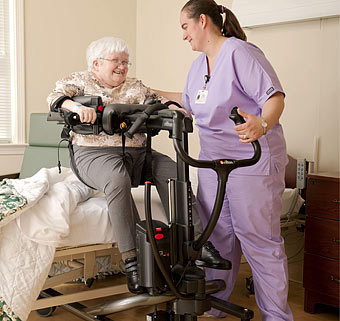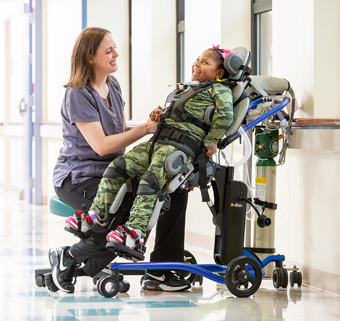Safe Patient Handling and Mobility
Using Equipment to Optimize Patient Outcomes
| August 2013Physical and occupational therapists, though keenly cognizant of ergonomic issues, are still at risk for work-related musculoskeletal injuries.1,2 In fact, therapists may be more susceptible than others to this type of injury considering the nature of their work, involving repetitive and sustained forces for soft tissue treatment and lifting and transferring patients.3 Even when using careful body mechanics, the literature informs us that lifting more than 35 pounds when transferring a patient places the clinician at risk for injury.4
 Margaret Arnold is a physical therapist and the Safe Patient Handling (SPH) Coordinator of McLaren Bay Region acute care hospital in Bay City, Michigan. She is certified both as an Ergonomics Evaluation Specialist and a Safe Patient Handling Specialist and works as a consultant nationwide, specializing in integration of safe patient handling to maximize patient outcomes in rehabilitation. Working with acute care, outpatient, and rehab departments, she’s learned that therapists often put their role as care providers above their own health and safety. Therapists are not motivated to discontinue manual lifting simply to prevent injury to themselves. But when they realize that their own pain and disability can negatively impact quality of care to their patients, this captures their attention.
Margaret Arnold is a physical therapist and the Safe Patient Handling (SPH) Coordinator of McLaren Bay Region acute care hospital in Bay City, Michigan. She is certified both as an Ergonomics Evaluation Specialist and a Safe Patient Handling Specialist and works as a consultant nationwide, specializing in integration of safe patient handling to maximize patient outcomes in rehabilitation. Working with acute care, outpatient, and rehab departments, she’s learned that therapists often put their role as care providers above their own health and safety. Therapists are not motivated to discontinue manual lifting simply to prevent injury to themselves. But when they realize that their own pain and disability can negatively impact quality of care to their patients, this captures their attention.
“Many times, therapists undertreat their patients due to their own pain,” says Arnold. “Last patient of the day—you’ve already lifted six or seven patients out of bed. When equipment is not available to help, the risk is that the therapist may choose to do bed exercises with that person rather than getting them up and walking. That’s the real impact.”
In confirmation of Arnold’s observations, research indicates that therapists in the United States typically continue to work despite pain.1,5,6 And this work-related pain does have its effect on patient care. In one study, more than 70% of PTs and OTs with work-related pain reported altering their work habits because of their pain. In the words of some therapists interviewed for the study, “sometimes you do other things with the patients so you don’t have to transfer them,” and “I hate to admit it, but my 4-6:00 pm patients might be getting gypped.7”
Although therapists certainly experience work-related injuries, statistics specifically related to therapist on-the-job injury are not easy to come by.8,9 The Bureau of Labor Statistics only uses the broad category “other health professionals” and does not capture data specifically about therapists. Nonetheless, the relevance of safe patient handling for rehabilitation and therapy professionals is becoming increasingly recognized and applied. The term “Safe Patient Handling and Mobility” (SPHM) has been coined to reflect the changing attitude towards safe patient care across the health care spectrum. In fact, the American Nursing Association has been actively promoting safe patient handling for close to two decades now.10
More recently, the American Physical Therapy Association endorsed the use of modern patient handling technology as part of a comprehensive SPHM program for providing therapy in rehabilitation settings.11 Rather than relying on a therapist’s physical strength to support a dependent patient, equipment is used to accomplish transfers and help patients with their mobility.
“Therapists need to be open-minded toward SPHM. There was some hesitancy thinking that using equipment promotes dependency because everyone is lifted and we won’t do rehab,” says Joyce Julien, PT, the director of therapy services at St Elizabeth Healthcare in Edgewood, Kentucky. “But with implementing the use of equipment, we found that patients feel safer being moved and we can go on with rehabilitation successfully. Our PTs have been totally accepting of the program.”
In addition, too often therapists mistakenly think that the use of patient-handling equipment will impede a patient’s ability to improve function and independence. Although concern about effects of SPHM on patient outcomes is understandable, the good news is that both therapists and patients can benefit from using these devices in the context of therapeutic intervention.12 There is no evidence that the use of patient-handling technology undermines rehabilitation goals, and the research shows that these practices enhance the safety of rehabilitation care providers.13,14,15
As Kathleen Rockefeller, PT, ScD, MPH noted, “It’s important to communicate the message that therapists no longer have to feel that their backs have to be a hoist. If we put ourselves in a situation with the potential to jeopardize our own health, then it doesn’t do us any good and it doesn’t do our patients any good. The question to ask is: how can we protect ourselves and the patient, and also facilitate the patient’s rehabilitation? There are options available for improved safety. We just need to get the word out.”
Kathleen is an associate professor and research coordinator at the Nova Southeastern University DPT program. She goes on to say, “As therapists, with our background, knowledge, and skills, we’re well-situated to be involved with the ergonomics and safe patient handling training programs of our facilities. We should be at the table, participating in the committees and making recommendations for equipment selection.”
In many settings, physical and occupational therapists can play a key role as trainers for the implementation and follow-through for a facility’s SPHM program.
The Association of Safe Patient Handling Professionals (ASPHP) is a non-profit corporation that has been formed to provide a venue for individuals interested in the science of safe patient handling. ASPHP is recognized as the standard-bearer of the profession, and offers clinicians the opportunity to be certified for having the specialized skills, knowledge and experience that make safe patient handling programs successful.
Through ASPHP, clinicians can access education and information, and advance their professional status through a certification program based on recognized standards. This certification qualifies health care professionals to establish and manage all aspects of a safe patient handling program.
Recognizing the benefits and implementing SPHM in rehabilitation is evidence-based practice and will continue to expand throughout facilities in the United States as a critical step to improve quality of care. Administrators will look to certified professionals to lead efforts to keep their employees safe and injury free, and to promote best practices for patient safety and rehabilitation.
References
1. Campo M, Weiser S, Koenig KL, Nordin M (2008). Work-related musculoskeletal disorders in physical therapists: A prospective cohort study with 1-year follow-up. Physical Therapy, 88(5):608-619. Abstract
2. King P, Huddleston W, Darragh AR (2009). Work-related musculoskeletal disorders and injuries: differences among older and younger occupational and physical therapists. J Occupational Rehabilitation 19(3):274-283. Abstract
3. Darragh AR, Campo M, King P. (2012) Work-related activities associated with injury in occupational and physical therapists. Work 42(3):373-84. doi: 10.3233/WOR-2012-1430. Abstract
4. Waters TR (2007). When is it safe to manually lift a patient? American Journal of Nursing 107(8):53-58. Abstract
5. Darragh AR, Huddleston W, King P. (2009) Work-related musculoskeletal injuries and disorders among occupational and physical therapists. Am J Occup Ther 63(3):351-362. Abstract
6. Cromie JE, Roberston VJ, Best MO (2002) Work-related musculoskeletal disorders and the culture of physical therapy. Physical Therapy 82(5):459-472. Abstract
7. Campo M, Darragh AR (2010). Impact of work-related pain on physical therapists and occupational therapists. Physical Therapy (90)6:905-920. Abstract
8. Cromie JE, Robertson VJ, Best MO (2000). Work-related musculoskeletal disorders in physical therapists: Prevalence, severity, risks, and responses. Physical Therapy 80(4):336-351. Abstract
9. Glover W, McGregor A, Sullivan C, Hague J (2005). Work-related musculoskeletal disorders affecting members of the Chartered Society of Physiotherapy. Physiotherapy 91(3):138-147. Abstract
10. Foley, M., (September 30, 2004). "Caring for Those Who Care: A Tribute to Nurses and Their Safety". Online Journal of Issues in Nursing. Vol. 9 No. 3, Manuscript 1.
11. Waters TR, Rockefeller K (2010). Safe patient handling for rehabilitation professionals. Rehabil Nurs 35(5):216-222. Abstract
12. Darragh AR, Campo M, Olson D (2009). Therapy practice within a minimal lift environment: perceptions of therapy staff. Work: A Journal of Prevention, Assessment, and Rehabilitation. 33(3):241-253. doi: 10.3233/WOR-2009-0872. Abstract
13. Nelson A, Harwood KJ, Tracey CA, Dunn KL (2008). Myths and facts about safe patient handling in rehabilitation. Rehabilitation Nursing 33(1):10-17. Abstract
14. Campo M, Shiyko M, Margulis H, Darragh A (2013). Effect of a Safe Patient Handling Program on Rehabilitation Outcomes. Archives of Physical Medicine and Rehabilitation 94(1):17-22. Abstract
15. Arnold M, Campo M, Radaweic S, Wright L. (2011) Changes in Functional Independence Measure Ratings Associated with a Safe Patient Handling and Movement Program. Rehabilitation Nursing 36(4):138-144. Abstract







